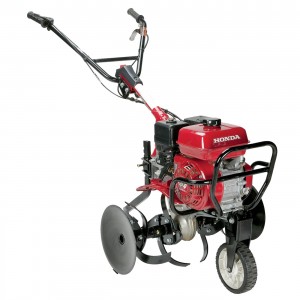 Throughout the spring and summer months, good tiller maintenance is absolutely essential in order to reduce costs and increase the efficiency of landscaping and maintenance work. Good maintenance will actually increase the efficiency of the tiller’s engine while reducing pollution, and a well-maintained tiller can cause less operator fatigue simply because it tends to run quieter and with less vibrations.
Throughout the spring and summer months, good tiller maintenance is absolutely essential in order to reduce costs and increase the efficiency of landscaping and maintenance work. Good maintenance will actually increase the efficiency of the tiller’s engine while reducing pollution, and a well-maintained tiller can cause less operator fatigue simply because it tends to run quieter and with less vibrations.
Excellent tiller maintenance throughout the warmer months of the year can also greatly reduce the risk of injury to operators, largely by ensuring that all of the tiller’s moving parts are in good working order and free of defects or problems that might pose problems. There are, however, a few things to know before engaging in routine tiller maintenance throughout the year.
The Blueprint: Referencing the Honda Tiller Maintenance Schedule
The Honda Mid-Tine Tiller comes with a maintenance schedule that covers when to check each part of the equipment, when to replace certain parts, and how often to perform routine fluid and lubrication checks. Consult this maintenance schedule, located in the user manual, to discern when to perform oil changes, replace or sharpen the tines, check the spark plug, and perform other key tasks. Beyond the maintenance schedule, here’s what to know when engaging in routine tiller service.
1. Refueling
The tiller should only be refueled once the engine has been allowed to cool down after a recent period of use. A cold or cool engine will reduce fumes and sparks, contributing to a much safer process overall. Operators who are concerned about the best type of fuel to use in the tiller throughout the summer should keep in mind the official recommendations from Honda:
– An octane rating of 86 or higher is required
– Diesel fuel is not compatible
– Ethanol concentration should never exceed 10 percent
– Methanol concentration should never exceed 5 percent
Following these recommendations will prevent significant damage to the engine that might otherwise result form poor-quality fuels, ethanol fuels, or diesel variants. When in doubt, consult the user manual for specific guidelines when refueling.
2. Engine Oil
Engine oil should be checked before each use of Honda’s Mid-Tine Tiller, and it should be fully changed at the beginning and end of each season at a minimum. IT may need to be changed as often as every 100 hours, based on how frequently the tiller is used throughout the spring and summer. Honda recommends a 10W30 oil formulation, since this particular oil is perfect for warmer temperatures common throughout the late spring and into the early autumn. Remember, low oil prior to equipment operation means that oil must be added to ensure continued safe and maintenance-free use of the equipment.
3. Transmission Fluid
Transmission fluid should be checked regularly, with most people preferring to do so prior to each tiller outing. The transmission oil generally should be filled up to the low level of the oil filler hole. If the fluid is lower than this point, additional transmission fluid should be added before the equipment is turned on and put into use. Failure to add new fluid can result in serious transmission problems and the potential for replacement of the transmission altogether. For specific instructions regarding the removal and addition of transmission fluid, consult the Honda tiller’s user manual.
4. Air Filter
The air filter should be checked before the tiller is used each time. If the filter shows excessive dirt buildup on the surface, it should be removed and cleaned with a mild detergent. When the filter is cleaned of this buildup, it can be reinserted into the equipment and the tiller can then be used. If the filter has been damaged by debris or excessive use, it should be completely replaced with an OEM Honda air filter.
5. Spark Plug
The spark plug should be inspected regularly by using a 5/8 wrench and removing it from the tiller completely. Check the spark plug for carbon residue and dirt buildup. If excessive, clean the spark plug so that it makes a cleaner, easier connection that will permit easier starting of the tiller itself. If the spark plug shows signs of damage or wear, replace it with an OEM Honda spark plug secured from a nearby retailer. Otherwise, simply place the old spark plug back into the equipment.
6. Spark Arrester
Spark arresters are an optional addition to Honda Mid-Tine Tillers. If one has been added, it should be serviced by an authorized retailer after every 100 hours of use. This regular service will ensure that the spark arrester continues performing its job capably and does not expose the equipment operator to injury or put the tiller at risk of damage.
Check HondaLawnParts.com for Honda Mid-Tine Tiller Parts and Service
For OEM replacement parts and the occasional professional service needed to keep the tiller in great condition, consider visiting HondaLawnParts.com. It’s the best and easiest way to find the right parts and the necessary expertise when the tiller needs either minor or significant repairs.
